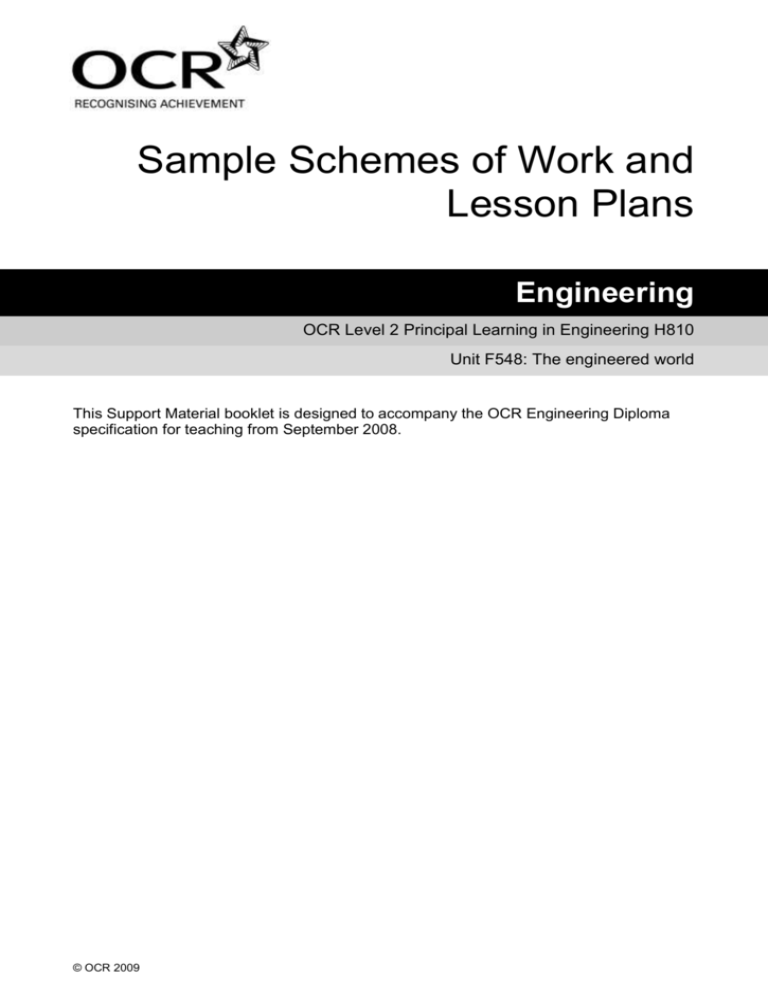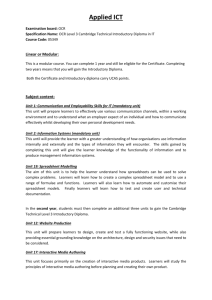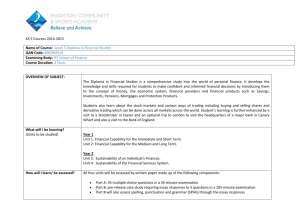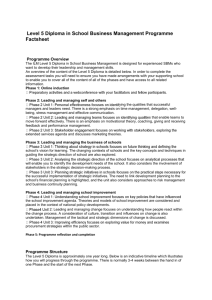OCR Nationals
advertisement

Sample Schemes of Work and Lesson Plans Engineering OCR Level 2 Principal Learning in Engineering H810 Unit F548: The engineered world This Support Material booklet is designed to accompany the OCR Engineering Diploma specification for teaching from September 2008. © OCR 2009 Contents Contents 2 Sample Scheme of Work: OCR Level 2 Principal Learning in Engineering H810 Unit: F548 The engineered world 3 Sample Lesson Plan: OCR Level 2 Principal Learning in Engineering H810 Unit: F548 The engineered world 2 of 16 14 Engineering Diploma Sample Diploma Scheme of Work OCR Level 2 Principal Learning in Engineering H810 Unit F548: The engineered world Suggested teaching time 60 GLH Topic outline Topic The engineered world Suggested teaching and homework activities Suggested resources Points to note Unit Overview: This unit will be assessed in a 10-minute digitally recorded viva-voce. Learners are required to give verbal responses to a set of questions, cues and allowable prompts provided to the presenter by OCR for each examination session. The questions will be based on the assessment criteria and will require learners to provide specific information based on investigations as well as analysis and reflection. It is anticipated at this level that learners may require some prompting and that the learning activity will be under direct supervision. The focus for the viva-voce is “The engineered world”. Where possible, links should be made with Engineering companies to allow candidates’ access and exposure to ‘real-life’ Engineering practice. Essentially the Engineering Diploma should be as hands on as possible with learners engaged in as many practical activities as is possible. The content of this unit should not be taught as excessive theory but in order to satisfactorily cover the required content some of the 60 GLH will, by necessity be of a “theoretical nature”. However care should be taken to not over face learners with such content and so teaching some aspects of this unit alongside other units to ensure a balanced and exciting learning experience. With this in mind the SOW and the exemplar Lesson plan compartmentalise content into a 30 minute learning activities to be interlaced with other more practical activities wherever possible. It is most desirable at this level of study learners are given a variety of activities and stimulus to fully engage them with Engineering. = Innovative teaching idea Engineering Diploma = ICT opportunity 3 of 16 Sample Diploma Scheme of Work OCR Level 2 Principal Learning in Engineering H810 Unit F548: The engineered world Suggested teaching time 60 GLH Topic The engineered world Suggested teaching and homework Suggested resources Points to note activities PLT’s are flagged in the topic outline but other opportunities for learners to develop and demonstrate their PLT’s exist in this unit. Likewise Functional skills are flagged but are generally fully integrated into the learning activities for this unit. Topic outline Learners will be able to: Identify and assess engineering achievements from two engineering sectors that have/have had demonstrable social and economic effects Identify the engineers associated with the development of the engineering achievements Identify and assess the social, = Innovative teaching idea 4 of 16 H/W Each Learner is given a different but specific topic e.g. “The engineering work of Sir Alexander Issigonis”, and asked to research as much as they can about the topic over a two week period. They will be asked to make notes and possibly have some visual images prepared to support their findings. Presenters will be selective of the topics given to learners which must be form the list in the points to note column. These should be topics which the presenter has some background or specific Resources will differ from sector to sector. However many generic resources are available at minimal cost to all centres. Newspaper and trade articles, together with many videos and CD-ROM support materials which are available e.g. on the North Sea Gas industry. The WWW should be used but in a controlled manner to discourage learners from the practise of downloading copious amounts of materials without understanding, applying or realising the true value of the materials. The learner should understand the contribution made by two of the following engineering sectors to social and economic development It is anticipated the presenter will select contributors to match the needs of the learner Transport railways, roads and bridges, steam ships: Brunel, Stephenson, Telford, Macadam, motorways, Channel Tunnel, Millau Viaduct Power and Utilities electricity generation: Faraday, power stations and high tension transmission, S Ferranti, steam turbine, Charles Parsons, nuclear power, E Fermi, The National Grid gas: North Sea gas = ICT opportunity Engineering Diploma Sample Diploma Scheme of Work OCR Level 2 Principal Learning in Engineering H810 Unit F548: The engineered world Suggested teaching time 60 GLH Topic outline Topic Suggested teaching and homework activities understand of and also ones which they are sure will be of interest to the group of learners. human, economic and political effects of a particular engineering achievement Identify and assess the social, human, economic and political issues that drove the achievement Identify and assess the technical issues faced by the developing engineer and any technical advances that the engineer relied/acted on (IE5, IE6) (Eng, ICT) = Innovative teaching idea Engineering Diploma The engineered world A dedicated lesson of 1 hour needs to be set aside for all the learners’ feedback which takes the form of the learner sitting in the front of the group and being asked several specific questions by the presenter which are designed to elicit appropriate information from the learners about the topic. (This is a prelude to the viva voce) – the same questions should therefore be asked to all the learners. This is followed by discussion with the presenter. Within the group, decisions are then made as to a smaller, select number (6 are suggested) of the topics that learners select Suggested resources Points to note water and sewerage treatment: J Bazalgette, D Cameron Civil Engineering and Building steel: Henry Bessemer, B Huntsman concrete: J Aspdin reinforcing: J Monier steel frame buildings: J Paxton, W L Jenney elevators: eg Otis environmental building controls: James Harrison commercial refrigeration: John Gorrie concept of air-conditioning: Franz Sangalli modern central heating Automotive automobiles: Daimler, F Lanchester, H Ford, A Issigonis, F Porsche, Mary Anderson – = ICT opportunity 5 of 16 Sample Diploma Scheme of Work OCR Level 2 Principal Learning in Engineering H810 Unit F548: The engineered world Suggested teaching time 60 GLH Topic outline Topic The engineered world Suggested teaching and homework activities as their two own to carry out further work on. They may work as part of a team when researching but evidence presented for assessment must be the sole ownership of each individual learner. Suggested resources Points to note windscreen Wipers Aircraft Frank Whittle, gas turbine, Barnes Wallis, geodetic airframe, John Stringfellow, Wright Brothers, heavier than air flight, Concorde, Airbus Biomedical Charles Dotter, cardiac stent, Willem Kollf, kidney dialysis, patient-controlled pacemaker, Leon Abrams and Ray Lightwood portable defibrilator, Frank Pantridge MRI Paul Lauterbur and Peter Mansfield Chemical and process Carl von Linde, liquefaction of air (related to refrigeration) William Perkin, Aniline Dyes = Innovative teaching idea 6 of 16 = ICT opportunity Engineering Diploma Sample Diploma Scheme of Work OCR Level 2 Principal Learning in Engineering H810 Unit F548: The engineered world Suggested teaching time 60 GLH Topic outline Topic The engineered world Suggested teaching and homework activities Suggested resources Points to note fractional distillation, B. Silliman oil refining, plastics moulding: Edith Flanigen Stephanie Kwolek: ‘Kevlar’ Patsy Sherman: ‘scotchgard’ Machine tools Whitworth, precision measuring machine Maudslay, centre lathe Ramsden, screw cutting lathe J Nasmyth, steam hammer and milling machine Jacquard, automated loom robots, CNC, CAD/CAM Lifestyle and household automatic washing machines, vacuum cleaner, Hoover, Dyson, Kenwood Braun, Remington, electric toothbrush, = Innovative teaching idea Engineering Diploma = ICT opportunity 7 of 16 Sample Diploma Scheme of Work OCR Level 2 Principal Learning in Engineering H810 Unit F548: The engineered world Suggested teaching time 60 GLH Topic outline Topic The engineered world Suggested teaching and homework activities Suggested resources Points to note Gillette, razor Electronics thermionic valve, Edison and De Forrest radio, Tesla and Marconi, T Baylis (sustainable) RADAR, cavity magnetron, H Boot and J Randall, microwave heating transistor, Brattain, Shockley and Bardeen microchip, W Dummer and J Kilby Ruby Laser, Theodore Maiman, Robert Dennard, memory chip optical fibre, John Tyndall and Narinder S Kapany = Innovative teaching idea 8 of 16 = ICT opportunity Engineering Diploma Sample Diploma Scheme of Work OCR Level 2 Principal Learning in Engineering H810 Unit F548: The engineered world Suggested teaching time 60 GLH Topic The engineered world Topic outline Suggested teaching and homework activities As part of a team and individually: Learners should understand the activities of the following engineering sectors and also the products and services within each sector: The learner should understand the purpose and contribution made by the following engineering sectors: Identify the industries represented by each of the sector skills councils Identify the products and services provided by each of the engineering sectors Identify the main engineering professional bodies and assess the nature of the work they do Identify and assess the merits = Innovative teaching idea Engineering Diploma energy and utility automotive built environment petrochemical manufacturing and scientific transport associated sub-sectors Suggested resources Points to note energy and utility automotive built environment petrochemical manufacturing and scientific transport Associated sub-sectors: engineering professional bodies and Skills Councils Lesson Plan 1 Card games. Presenter to follow up on selected product Learners should also appreciate that some aspects of engineering do not sit conveniently within the above sectors; they may fall outside or relate to more than one sector = ICT opportunity 9 of 16 Sample Diploma Scheme of Work OCR Level 2 Principal Learning in Engineering H810 Unit F548: The engineered world Suggested teaching time 60 GLH Topic outline Topic The engineered world Suggested teaching and homework activities Suggested resources Points to note and sectors in future lessons and supported by industrial visits. of the registration schemes associated with different engineering trades (IE4, TW1, TW2, TW6) (Eng, ICT) As part of a team and individually: A structured industrial visit / work placement with “questions to answer” as one of the foci during the visit / placement. Assess the different craft roles, their basic duties and responsibilities The ideal situation would be comparative activity for learners from several such visits to be able to compare roles and responsibilities and the application of rights etc. as they apply to different sized companies and sectors. Theory top up activities should be delivered in as integrated and fun manner as Assess the different technician roles, their basic duties and responsibilities = Innovative teaching idea 10 of 16 Basic calculation For a basic calculation of your leave allowance multiply the number of days you work a week by 5.6. For example, if you work a five day week you would be entitled to 28 day' annual leave a year: 5 days x 5.6 weeks = 28 days For more complex holiday entitlement calculations you can use the employee The learner should understand and recognise the importance and purpose of: craft, technical and professional roles training and careers basic rights and responsibilities of employees rights and duties of employers terms of employment pay holiday entitlement benefits health & safety = ICT opportunity Engineering Diploma Sample Diploma Scheme of Work OCR Level 2 Principal Learning in Engineering H810 Unit F548: The engineered world Suggested teaching time 60 GLH Topic outline Assess the different professional roles, their basic duties and responsibilities Topic The engineered world Suggested teaching and homework activities possible. Identify and assess the basic rights of individuals in paid employment Suggested resources Points to note holiday calculator on businesslink.gov.uk. An example might be to ask each learner to write down how many days per week they would ideally like to work. Then the info in column 3 of this document could be projected on a screen and learners asked to work out how much paid holiday they would then get. Identify and assess the This exercise should last no more than 10 responsibilities of individuals in minutes to avoid prolonged “theory” paid employment activities. Identify and assess the rights and duties of employers There is considerable content in the points to note column and the content should be broken down and covered in a series of short exposures to learners as appropriate. (IE4, TW1, TW2, TW6, EP2) (Eng, ICT) = Innovative teaching idea Engineering Diploma = ICT opportunity 11 of 16 Sample Diploma Scheme of Work OCR Level 2 Principal Learning in Engineering H810 Unit F548: The engineered world Suggested teaching time 60 GLH Topic outline Identify and assess at least one environmental effect and its cause. Express views from the perspective of each of the two chosen engineering sectors Identify and assess ways in which engineering protects the environment Discriminate between renewable and non-renewable resources Identify and assess methods of recycling Materials = Innovative teaching idea 12 of 16 Topic The engineered world Suggested teaching and homework activities Suggested resources Points to note The learner should understand environmental effects of different industries: Newspaper article, (copied for each learner or on PowerPoint) ideally controversial, dealing with any one aspect of environmental effects which apply to engineering businesses as per points to note column. Either projected via DPL or a photocopy of article for each small group of learners to read, digest and discuss in larger forum. Presenter discussion and technical content delivered on the aspects of the environmental issues concerned. gas emissions, chemical use in processes and agriculture, building, mining, quarrying and landfill operations waste treatment and disposal, natural resources and petroleum dependence, renewable resources Statistical and mathematical derivation of information from a scenario or graphical situation is an important aspect of this unit There is considerable content in the points to note column and the content should be broken down and covered in a series of = ICT opportunity Engineering Diploma Sample Diploma Scheme of Work OCR Level 2 Principal Learning in Engineering H810 Unit F548: The engineered world Suggested teaching time 60 GLH Topic outline Topic The engineered world Suggested teaching and homework activities Suggested resources Points to note exposures to learners as appropriate. Identify and assess methods of conserving materials Interpret numerical and graphical information to derive information on environmental effects and conservation of resources = Innovative teaching idea Engineering Diploma = ICT opportunity 13 of 16 Sample Diploma Lesson Plan OCR Level 2 Principal Learning in Engineering H810 Unit F548: The engineered world Engineering sectors and associated job roles OCR recognises that the teaching of this qualification above will vary greatly from school to school and from teacher to teacher. With that in mind this lesson plan is offered, as a possible approach but will be subject to modifications by the individual teacher. Lesson length is assumed to be 30 minutes (See overarching comments in SOW.). Learning Objectives for the Lesson Objective 1 Learners to know the 10 engineering sectors Objective 2 Learners to identify products and services within each engineering sector Objective 3 Learners to be able to understand that there are a number of different engineering activities within each sector Recap of Previous Experience and Prior Knowledge Engineering: The industry is concerned with the design, maintenance, production and selling of a vast range of different engineered products Sectors Engineering is a generic term and for ease of understanding is broken down in to “material and process” based sectors Focus area: The knowledge that there are many different products and services within engineering. Prior to this basic introduction the presenter will have prepared a series of “playing cards” possibly laminated (reason for lamination 1: can be re-used reason 2: shows the importance of the activity). Intro level: Blue cards will have the ten sectors / sub-sectors boldly printed on them. Two duplicates per game so 20 cards in total. Intro level: Brown cards will have a number of different products and services which are identified on the cards. Each product or service is directly related to a specific engineering sector (sub-sector). An example might be “Rack and pinion steering mechanism” which is related to the “automotive sector”. Two specific products or services cards per sector so 20 cards in total. The use of images as well as text will also support some learners. 14 of 16 Engineering Diploma Sample Diploma Lesson Plan Content Time Content 5 minutes Explanation of proposed lesson structure: A card game for two players plus a referee (3rd player). Player 1 has a pack of Blue cards (sector cards) Player 2 has the pack of Brown cards (product and services cards) Player 3 has a definitive list of the sectors and the products and services used in the game and acts as a referee. 10 minutes Phase 1: Learners Activity: In pairs (2 players): Each of the 2 players has the 20 cards at their disposal. The referee has a definitive printed list of the relationships between sectors and products / services which only includes the products and services used in the game. Player 1 lays a sector card on the table and player 2 then lays a product / service card on the table. The first player to shout “engineering” to correctly identify a relationship between the sector and the product / service gains 1 point. If a player makes an incorrect decision they lose 1 point. The referee decides if the relationship is correct. Once a correct relationship is identified those particular cards are discarded and the game continues with the remaining cards each pack shuffled at the end of the cycle. 10 minutes Phase 2: Cards are put back into the two packs. Pack 2 is shuffled and placed face down on the table in front of both players. The sectors pack (Pack 1) is temporally discarded and the brown pack (Pack 2 products and services is used). Player 2 turns over a product or services card. Player 1 orally states: which sector the product or service is associated with. If correct they gain 1 point and have the extension opportunity for 3 extra points. If player 1 incorrectly makes the association between the product or service the extension opportunity goes to player 2 *. Extension opportunity: The player can now state up to three different products or services associated with the same sector. If correct they gain 1 point for each correct response. BUT as soon as an incorrect response is made no marks are gained for that round and the extension opportunity goes to the other player. * Player 2 now has the opportunity to correctly identify up to three different Engineering Diploma 15 of 16 Sample Diploma Lesson Plan products or services for the same sector and they can gain up to 3 points. BUT as soon as an incorrect response is made no marks are gained for that round and the extension opportunity goes to player 1. The player with the highest number of marks wins the game. Consolidation Time Content 5 minutes Learners reset the packs of cards in colour order for future activity and return them to the presenter. Presenter summarises lessons activity and explains what will happen next lesson. Next lesson, working in workbook or on pre-printed worksheets, learners will have to identify the correct sector for the products and services identified by the presenter. This could be done using PowerPoint, holding up the cards or reading them from the cards. Images rather than text or oral communication can deepen the challenge. This to be done in test conditions to assess general learning. End of lesson. 16 of 16 Engineering Diploma






